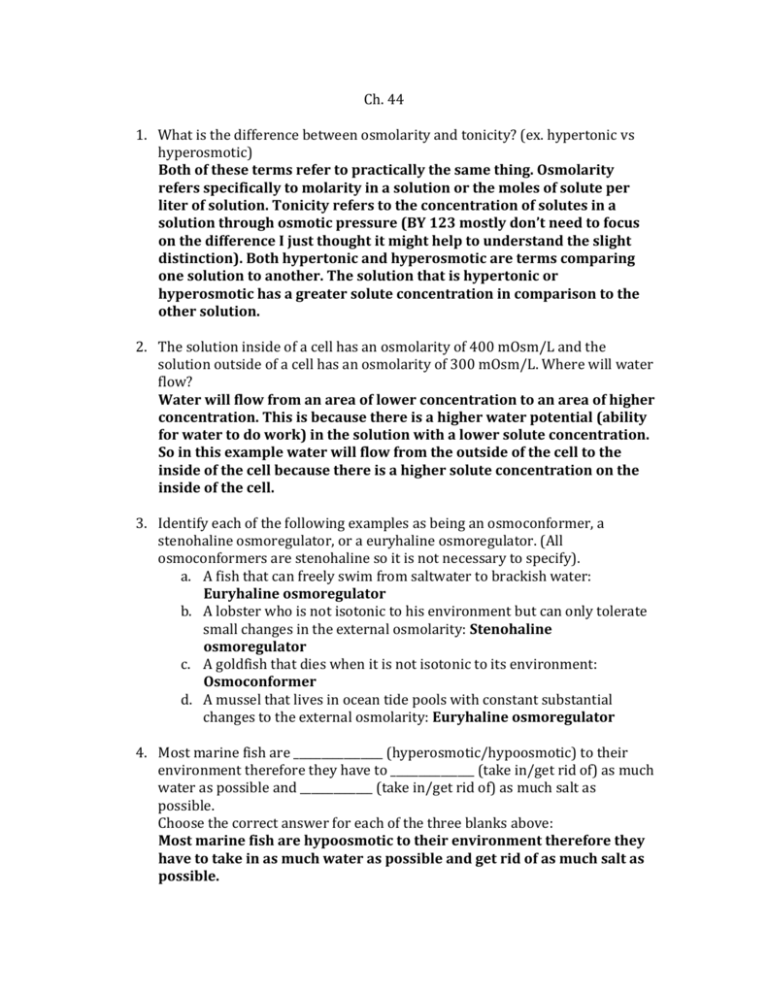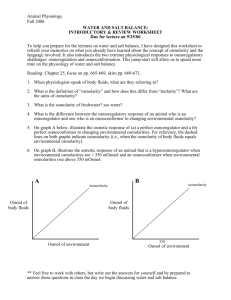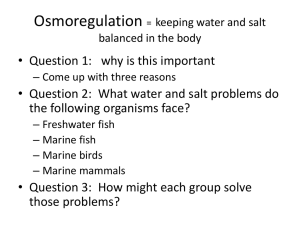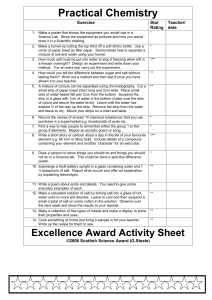Ch. 44 1. What is the difference between osmolarity and tonicity? (ex
advertisement

Ch. 44 1. What is the difference between osmolarity and tonicity? (ex. hypertonic vs hyperosmotic) Both of these terms refer to practically the same thing. Osmolarity refers specifically to molarity in a solution or the moles of solute per liter of solution. Tonicity refers to the concentration of solutes in a solution through osmotic pressure (BY 123 mostly don’t need to focus on the difference I just thought it might help to understand the slight distinction). Both hypertonic and hyperosmotic are terms comparing one solution to another. The solution that is hypertonic or hyperosmotic has a greater solute concentration in comparison to the other solution. 2. The solution inside of a cell has an osmolarity of 400 mOsm/L and the solution outside of a cell has an osmolarity of 300 mOsm/L. Where will water flow? Water will flow from an area of lower concentration to an area of higher concentration. This is because there is a higher water potential (ability for water to do work) in the solution with a lower solute concentration. So in this example water will flow from the outside of the cell to the inside of the cell because there is a higher solute concentration on the inside of the cell. 3. Identify each of the following examples as being an osmoconformer, a stenohaline osmoregulator, or a euryhaline osmoregulator. (All osmoconformers are stenohaline so it is not necessary to specify). a. A fish that can freely swim from saltwater to brackish water: Euryhaline osmoregulator b. A lobster who is not isotonic to his environment but can only tolerate small changes in the external osmolarity: Stenohaline osmoregulator c. A goldfish that dies when it is not isotonic to its environment: Osmoconformer d. A mussel that lives in ocean tide pools with constant substantial changes to the external osmolarity: Euryhaline osmoregulator 4. Most marine fish are ________________ (hyperosmotic/hypoosmotic) to their environment therefore they have to _______________ (take in/get rid of) as much water as possible and _____________ (take in/get rid of) as much salt as possible. Choose the correct answer for each of the three blanks above: Most marine fish are hypoosmotic to their environment therefore they have to take in as much water as possible and get rid of as much salt as possible. 5. Most freshwater fish are ________________ (hyperosmotic/hypoosmotic) their environment therefore they have to _______________ (take in/get rid of) as much water as possible and _____________ (take in/get rid of) as much salt as possible. Most freshwater fish are hyperosmotic to their environment therefore they have to get rid of as much water as possible and take in as much salt as possible. 6. Define transport epithelia? How do transport epithelia help the albatross to successful drink seawater? Transport epithelia are layers of specialized epithelial cells that can control the movement of various solutes in specific directions in order control osmoregulation. The albatross uses transport epithelia in a nasal gland to extract salt from the blood and put it into a secretory tubule that leads to the nostril where salt is excreted. The salt extraction is enhanced by a countercurrent exchange system in which blood flows the opposite direction of the salt ions in the secretory tubule, however, active transport is still necessary to extract the necessary amount of salt. 7. Decide if each of the following traits/characteristics are referring to ammonia, urea, or uric acid: a. The most toxic for of nitrogenous wastes: Ammonia b. Mammals and sharks use this form: Urea c. Requires no energy to produce: Ammonia d. Birds use this form: Uric Acid e. Is the most energy costly to produce: Uric Acid f. Is less toxic than ammonia but more toxic than uric acid: Urea 8. What are the four key steps in the excretory process? Filtration, Reabsorption, Secretion, and Excretion. 9. What type of excretory system does each of the following use: a. Vertebrates: Kidneys b. Earthworm: Metanephridia c. Insects: Malpighian tubules d. Flatworms: Protonephridia 10. Would cortical or juxtamedullary nephrons be more useful for producing very concentrated urine? Why? The juxtamedullary nephrons would be more useful for producing very concentrated urine. This is because the have a loop of Henle that extends much farther down into the renal medulla. This extension of the loop of Henle maintains a steep osmotic gradient so that the urine will become much more concentrated in the collecting ducts. 11. What is the main event occurring in the descending limb of the loop of Henle? Water is being reabsorbed in the descending loop of Henle. 12. Why is salt transported to the interstitial fluid in the ascending limb of the loop of Henle? Salt is transported to the interstitial fluid in the ascending loop of Henle to help maintain the osmolarity in the medulla. The interstitial fluid is more hyperosmotic as move down from the cortex to the inner medulla. This ultimately allows for the efficient reabsorption of water. 13. True or False: The ascending limb of the loop of Henle is impermeable to water. True 14. The collecting duct… a. Is part of the loop of Henle b. Is permeable to H2O c. Is permeable to urea d. Is permeable to NaCl e. b and c f. b, c, and d OMIT THIS QUESTION. 15. Define counter current multiplier system: Any system that expends energy to maintain a concentration gradient. 16. If you were to consume a large amount of water it is likely that (high/low) levels of ADH would be secreted therefore (more/less) aquaporin channels would be inserted into the membrane of the collecting duct and (more/less) water would be reabsorbed. 17. ACE converts angiotensin I to angiotensin II. What does angiotensin II have to blood pressure/ volume? Angiotensin II causes the adrenal gland to release aldosterone which causes more sodium and water to be reabsorbed in the distal tubules which increases blood volume. It also causes arterioles to constrict which increases blood pressure.









